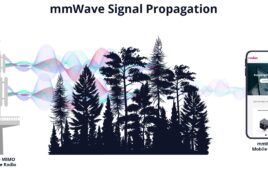5G Technology World spoke with Jonathan Oakley of Dassault Systemes on how the company’s electromagnetic simulation software helps engineers design and evaluate antennas for smartphones and IoT devices.
All wireless devices need antennas, which often must fit into tight spaces. While high-volume smartphones may use custom-designed antennas, IoT devices often use commercial off-the-shelf antennas. Companies that develop and manufacture IoT devices may not have the in-house expertise to design their own antennas and thus rely on buying them.
Whether you design your own or buy an antenna, it must function adequately when installed. The days of external antennas are long gone. That’s where electromagnetic simulation software from Dassault Systemes and others come in. Dassault’s Simulia software tools perform physics-based simulation of how electromagnetic fields propagate based on the physical structures — glass, metal, batteries, and so on — around them. We spoke with Dassault’s Jonathan Oakley about how engineers can use EM field simulation software to evaluate how antennas will function when installed into smartphones and IoT devices.

Electromagnetic simulation software can produce a model of how signals propagate in a smartphone, even when held in a person’s hand. Source: Dassault Systemes.
5GTW: What models of components do engineers need to perform an EM simulation?
Oakley: For electromagnetics, we can set up an antenna and see how it performs. Will it meet specs or interfere with other parts of the system? To do that, we bring in models of PCBs, casings, plastics, connectors, and other antennas — Wi-Fi, GPS, Bluetooth — into a system model and run simulations.
5GTW: Does your software take a “systems level” approach?
Oakley: That’s certainly part of it. We can look at the component level and see how components work together in the system.
You can easily simulate an antenna, but what happens when you put it inside a device? Will casing, glass, or metal change performance? Plus, people hold phones near their heads. We need to simulate that as well.
5GTW: Let’s look at IoT devices rather than smartphones. How does Dassault Systemes work with IoT designers?
Oakley: The predictions are for billions of connected devices. Applications range from smart homes to industrial, asset tracking, smart cities, and so on. The number of connected devices per square mile will also increase. Every machine and person in a factory, for example, will have a smart, wirelessly connected device. We see the wired factory transforming into the wireless factory and we think 5G will help make that happen.
IoT has several wireless protocols, the most popular being Wi-Fi, Bluetooth, ZigBee, and LPWAN, used when you need long battery life up to ten years but with limited bandwidth. 5G offers higher performance and low latency — the response can be fast enough to provide a feedback loop for industrial control. That’s why we think 5G will proliferate. Of course, all wireless technologies require antennas and matching circuits. Simulation lets engineers study latency, interference, signal strength, and other factors.
5GTW: How does simulation on a mobile device differ from simulation on a stationary device?
Oakley: 5G has three general bands, roughly 600 MHz, 3.5 GHz, and mmWave above 26 GHz. The mmWave frequencies provide high bandwidth but at short range, maybe one city block. Carriers use all three to provide the best overall user experience. For example, mmWave is popular in stadiums. Low band is popular in rural areas because of its long range and best coverage.
To make this work, you need directional antennas, especially at mmWave frequencies because of their short range and easy blockage. You need steerable arrays to direct the energy and save battery life. Beam steering lets a mobile device connect to a base station by adjusting a signal’s amplitude and phase. Base stations also need steerable beams to track the mobile devices in its range. MU-MIMO also lets base stations track multiple users at the same time. The same applies to IoT. Look at factories where you have machines moving around such as for delivering parts. Beam steering enables flexible factories that are not possible with wired communications. Several such factories are online in Europe.

Antennas designed into a smartphone must fit into tight spaces. Simulation software lets engineers model how an antenna performs when installed int the device.
5GTW: Let’s assume that an engineer chooses to purchase an antenna for an IoT device. You can get performance data from the manufacturer but now you need to model and simulate its environment — electronics, glass, case battery, etc. How do you get the data to model the entire package? How do you create a system model?
Oakley: We start with a CAD model, say from SolidWorks, and we bring in the geometry, which contains dimensions and materials information. We call that ModSim — modeling plus simulation. Designers work on the mechanical design while engineers work on the EM environment.
To complete the simulation, you need information on your device’s the materials. We have a library of materials and their characteristics that engineers use in simulations. You can assign the characteristics to the materials in your design. You’ll also need to decide how you want to drive the antenna. The simulation will take all values into account. Fundamentally, we’re solving Maxwell’s Equations.
Simulation software lets engineers change parameters and see the results, including the cumulative distribution function (CDF) and power density.
Because of space constraints, smartphone engineers can’t usually purchase antennas. They must design their own to fit in the space. If you look at a smartphone teardown, you’ll see the antennas may wrap around batteries. In other designs, the casing may even become the antenna. That’s another advantage of simulation, it’s a 3D tool.
5GTW: Please explain CDF for readers who may be unfamiliar with the term.
Oakley: CDF describes how well a 5G device covers its area. For example, an antenna manufacturer might provide data on how its 2×2 MIMO antenna functions, but what about when it’s installed into a phone behind a glass screen or in a corner behind a plastic window? That performance may change. The CDF provides data that helps you decide how to drive the antenna to restore its full performance.
5GTW: How do you use simulation software to model an antenna’s performance as a receiver?
Oakley: It’s reciprocal. The receive pattern will be the same as it’s transmit pattern.
5GTW: How much time might an engineer spend simulating an antenna?
Oakley: It’s an increasing amount, and 5G has increased the amount of time engineers spend doing simulation. Devices such as phones are nearly impossible to design without simulation. You must not only consider signals, but thermal and mechanical issues are well. It’s a Multiphysics problem. You could spend months in a test chamber without simulation software.
5GTW: With an IoT device, you might not have the same space limitation as in a smartphone, but an IoT company might not have the same antenna expertise as a smartphone company. How does using a purchased antenna affect how an engineer might use simulation?
Oakley: We have customers who design smartphones and IoT devices while others design IoT connectivity modules and antennas. Still others provide the metals and other materials. Antenna manufacturers don’t know how you’re going to use their products. They just provide data on free-space performance. As a system integrator, you could ask your supplier for a SolidWorks model, then run a simulation before you buy components.
5GTW: Does simulation software let engineers evaluate the spectrum of a transmitted signal and can it simulate the attenuation or interference from other devices?
Oakley: For radiated emissions, devices can’t emit signals outside their intended use frequencies. That’s regulated by governments and standards organizations. For radiated susceptibility, that’s not necessarily regulated but you have to simulate signals coming from other devices. We can create a virtual anechoic chamber. We can put probes into a device model to see how it attenuates outside noise.
<br clear=all>






Tell Us What You Think!